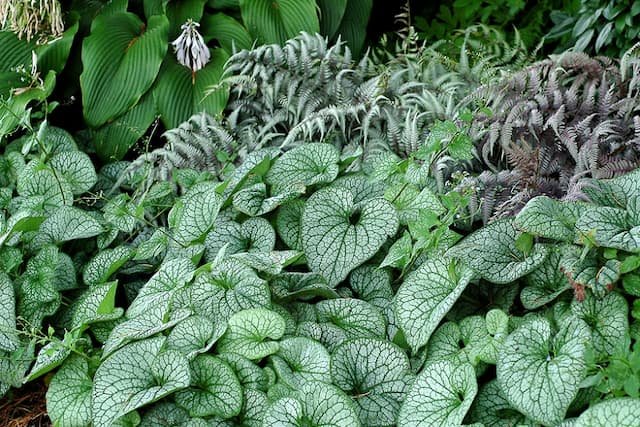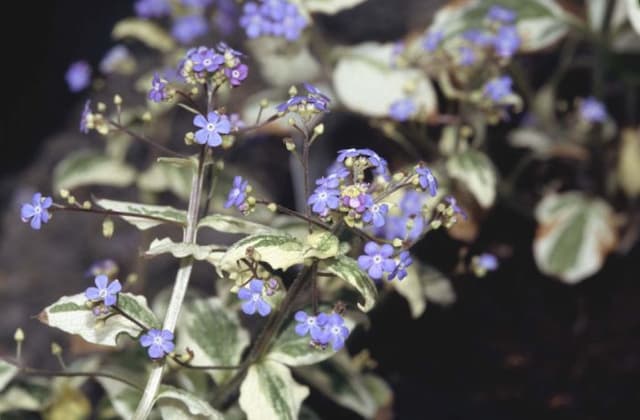Five-spot Nemophila maculata

ABOUT
Nemophila maculata, commonly known as five-spot, is a charming annual plant that is well-loved for its decorative appeal. The most striking feature of this plant is its lovely flowers. Each bloom presents a crisp white backdrop, with each of its five rounded petals typically adorned with a deep purple to black spot at the tip, giving the appearance of a spotted pattern. This striking contrast is what has earned it the name five-spot. The blossoms form a bell-like shape that is mildly cupped, creating a delicate and whimsical silhouette that adds interest to garden spaces. The foliage of the five-spot is also attractive, being composed of delicate, green leaves that are finely dissected, giving them a feather-like appearance. The leaves are arranged alternately on the stems, which branch out to create a lush, full-bodied plant. Overall, the appearance of five-spot is one of dainty and detailed beauty, with its contrasted blossoms set against lacy, light green leaves, making it a delightful choice for garden beds, borders, and containers where its floral display can be appreciated up close.
About this plant
 Names
NamesFamily
Boraginaceae
Synonyms
Five-Spot, Baby Blue Eyes
Common names
Nemophila maculata
 Toxicity
ToxicityTo humans
Nemophila maculata, commonly known as Five-Spot, is not widely recognized as a toxic plant to humans. There are no well-documented cases or common knowledge of toxicity surrounding this plant that would generally raise alarm for human health if touched or ingested. However, as with any plant, individual allergic reactions are possible, and it is generally advisable not to consume any plant parts unless you are certain of their safety and edibility.
To pets
Five-Spot is not known to be toxic to pets. There is limited information on the toxicity of Nemophila maculata to animals, but it is not listed among commonly recognized poisonous plants for pets like dogs and cats. Nonetheless, pet owners should always exercise caution and prevent pets from ingesting plants, as individual animals may have different sensitivities or allergic reactions, and any plant material can potentially cause gastrointestinal upset in pets if eaten in large quantities.
 Characteristics
CharacteristicsLife cycle
Annuals
Foliage type
Deciduous
Color of leaves
Green
Flower color
Mixed
Height
1 foot (0.3 meters)
Spread
1 foot (0.3 meters)
Plant type
Herb
Hardiness zones
6
Native area
North America
Benefits
 General Benefits
General Benefits- Aesthetic Appeal: Nemophila maculata, commonly known as Baby Blue Eyes, offers vibrant blue flowers that can enhance the visual attractiveness of gardens and landscapes.
- Pollinator Attraction: The blossoms of Nemophila maculata attract a variety of pollinators such as bees and butterflies, supporting biodiversity.
- Easy to Grow: Baby Blue Eyes are known for being easy to cultivate, requiring minimal maintenance, which makes them suitable for novice gardeners.
- Cool Weather Tolerance: This plant thrives in cooler temperatures, which can provide an early season burst of color in areas with mild springs.
- Groundcover Usage: The low-growing habit of Nemophila maculata makes it an excellent choice for groundcover, suppressing weeds and minimizing soil erosion.
- Companion Planting: Baby Blue Eyes can be used in companion planting to create visually appealing combinations in flower beds and borders.
- Edging Plants: Due to their compact growth, they are ideal for edging along paths or garden borders.
- Container Gardening: They can thrive in containers, allowing those with limited space to enjoy their beauty on patios or balconies.
 Medical Properties
Medical PropertiesThis plant is not used for medical purposes.
 Air-purifying Qualities
Air-purifying QualitiesThis plant is not specifically known for air purifying qualities.
 Other Uses
Other Uses- Nemophila maculata, commonly known as Baby Blue Eyes, can be used as a dye for fabrics due to its natural pigments that can impart a subtle color.
- Baby Blue Eyes plants are great for educational purposes in schools for teaching about plant biology and life cycles due to their rapid growth and ease of care.
- The ground foliage of Baby Blue Eyes can serve as a living mulch, helping to retain soil moisture and suppress weeds around taller plants in a garden setting.
- Nemophila maculata seeds are often used in crafts, such as natural seed jewelry, due to their unique shape and texture.
- Because of its attractive flowers, Baby Blue Eyes is used in horticultural therapy programs to provide a calming and nurturing environment for participants.
- The nectar-rich blossoms of Baby Blue Eyes can be integrated into butterfly gardens to attract and support butterfly populations.
- Baby Blue Eyes can be planted between vegetable rows to act as a decoy for pests, minimizing damage to vegetable crops.
- Used for creating natural and biodegradable confetti for events such as weddings, due to the delicate nature of its petals.
- This plant is often involved in citizen science projects that monitor the effects of climate change on flowering times and plant growth.
- Baby Blue Eyes is used in floral arrangements designed for spring celebrations and as part of Easter decorations due to its early blooming.
Interesting Facts
 Feng Shui
Feng ShuiBaby Blue Eyes is not used in Feng Shui practice.
 Zodiac Sign Compitability
Zodiac Sign CompitabilityBaby Blue Eyes is not used in astrology practice.
 Plant Symbolism
Plant Symbolism- Delicacy and Gentleness: The Nemophila maculata, commonly known as Five Spot, is a delicate flower whose appearance conveys a sense of gentleness and fine qualities.
- Innocence: The white petals of the Five Spot often symbolize purity and innocence, reflecting the unassuming nature of the flower.
- Forgiveness: In floral language, white flowers can also represent forgiveness, suggesting a gesture of peace and reconciliation.
- Youth: The Five Spot blooms early in the spring, making it a symbol of youth and the new beginnings associated with the season.
- Connection to Nature: With its name derived from the words "nemos," meaning grove, and "philia," meaning love, the Five Spot embodies a deep connection to the natural world and its forested habitats.
 Water
WaterFive-spot, the common name for Nemophila maculata, should be watered deeply once a week to encourage strong root development, equating to roughly 1 to 1.5 inches of water each week. The actual frequency, however, can vary based on climatic conditions; for instance, in hotter, drier climates, you may need to water twice a week. Use a watering can or drip irrigation to water at the base of the plant to avoid wetting the foliage and potentially promoting fungal diseases. In cooler, cloudy or wet weather, reduce the watering frequency to prevent waterlogged soil, which can lead to root rot. During the growing season, check the soil moisture by feeling the soil about an inch below the surface; if it feels dry, it's time to water.
 Light
LightThe Five-spot thrives in full sun to partial shade. The ideal spot for this plant is an area that receives at least six hours of sunlight daily, preferably in the morning with some afternoon shade in hotter climates. These plants can also perform well in dappled sunlight, such as underneath a tree with light foliage, but too much shade can result in leggy growth and fewer blooms.
 Temperature
TemperatureFive-spot prefers moderate temperatures and does best in conditions that range between 55 to 75 degrees Fahrenheit. This plant can tolerate a minimum temperature of around 50 degrees Fahrenheit at night and should be safeguarded from frost, as it is sensitive to extreme cold. The optimal temperature settings allow for vigorous growth and abundant flowering.
 Pruning
PruningPruning Five-spot is not usually required, but deadheading, the process of removing spent flowers, can encourage continued blooming. It is best to prune or deadhead regularly throughout the blooming season to maintain plant vigor and aesthetic appeal. No specific time is best for pruning, as it can be done anytime during the growing season when flowers fade.
 Cleaning
CleaningAs needed
 Soil
SoilBaby Blue Eyes thrive in well-draining soil with a loamy texture, high in organic matter content. A good soil mix can be achieved with equal parts of loam, peat moss, and perlite or sand to ensure proper drainage. The ideal soil pH for Baby Blue Eyes should be slightly acidic to neutral, ranging between 6.0 and 7.0.
 Repotting
RepottingBaby Blue Eyes does not typically require frequent repotting as it is often grown as an annual. However, if grown as a perennial or when starting seeds in containers, repot every spring into fresh soil to provide nutrients and encourage growth.
 Humidity & Misting
Humidity & MistingBaby Blue Eyes thrives best in moderate humidity conditions. It does not require a specific humidity level but performs well in the natural range of outdoor environments where it typically grows, without the need for additional humidity control measures.
 Suitable locations
Suitable locationsIndoor
Place Baby Blue Eyes in a bright area and use well-draining soil.
Outdoor
Plant Baby Blue Eyes in well-drained soil, partial to full sun.
Hardiness zone
3-9 USDA
 Life cycle
Life cycleNemophila maculata, also known as five-spot, begins its life cycle when seeds are sown in well-draining soil and germinate with adequate moisture and cooler temperatures typical of spring or fall. The seedlings emerge with two embryonic leaves (cotyledons) followed by the development of true leaves, which display the plant's characteristic round shape and vibrant green color. As the five-spot grows, it develops a low, spreading habit and soon after, it produces distinctive white flowers with five purple spots, typically blooming from early spring to summer. After pollination, which is aided by various insects attracted to the blooms, the plant produces small, globular seed capsules. These capsules mature and eventually split open to disperse seeds, allowing for self-seeding if conditions are favorable. At the end of the growing season, Nemophila maculata is an annual plant and dies, relying on its seeds to propagate the next generation.
 Propogation
PropogationPropogation time
Spring
The most popular method of propagation for the Baby Blue Eyes (Nemophila maculata) is by sowing seeds directly into the ground. Optimal planting time is in the fall in warmer climates or early spring in cooler regions, after the threat of frost has passed. To propagate, prepare a well-draining soil bed in a spot that receives partial shade to full sun. Scatter the seeds lightly over the soil and cover them with a thin layer of soil, approximately 1/16th of an inch (1.5 mm) deep. Keeping the soil moist but not waterlogged is crucial for germination, which typically occurs within 7 to 14 days. Once seedlings have emerged and are big enough to handle, thin them out to around 6 to 12 inches (15 to 30 cm or 150 to 300 mm) apart to allow each plant enough space to grow. Baby Blue Eyes plants tend to flower in the spring and can create a carpet of blue when grown en masse.









